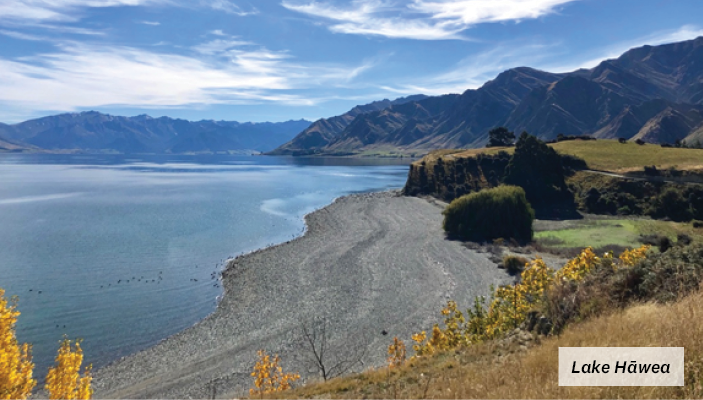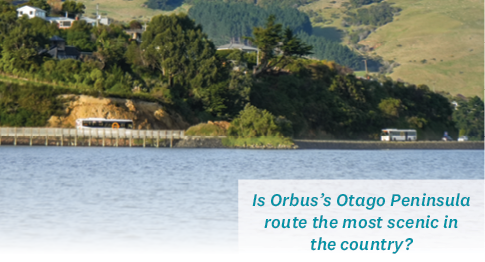-
-
-
-
-
-
-
-
-
-
The Source - Summer
-
-
-
-
-
-
-

Future focus for new chairperson
Good governance is at the heart of any effective organisation, and this will be front of mind as I chair Otago Regional Council for the next three years.
The role of Council has a strong purpose — we are here to represent the community — to listen, enable and deliver.
A challenge for the incoming Council is concerns people have raised about the cost of their rates.
A priority I have is to ensure ORC’s work is cost effective and value for money while maintaining the momentum of Otago’s environmental journey.
The community has shown they are keen to be involved, and the council needs to work with them to achieve the best results.
By working together we can achieve a thriving, prosperous and well-managed Otago, and I have no doubt we can be the best regional council in New Zealand.
It’s important that all of our communities have a voice — recent changes to councillor representation help to achieve this — giving fairer representation to the Dunstan area.
Otago Regional Council is in good heart and the future is bright. I look forward to making a positive difference for Otago.
Hilary Calvert, ORC Chairperson

Back row, left to right: Cr Matt Hollyer, Cr Andrew Noone, Cr Neil Gillespie, Cr Alan Somerville, Cr Gary Kelliher, Cr Kate Wilson.
Front row, left to right: Cr Gretchen Robertson, Cr Kevin Malcolm (Deputy Chairperson), Cr Hilary Calvert (Chairperson), Cr Chanel Gardner, Cr Robbie Byars. Inset: Cr Michael Laws.
Meet your councillors: orc.govt.nz/councillors

A welcome $4.7 million government boost to support six flood protection projects across the Clutha district and near Mosgiel will help keep Otago’s communities, farms and roads safer.
Repeated floods since 2017 have taken their toll on infrastructure, and the work will strengthen floodbanks, upgrade key structures, and protect 13,000 people and nearly $6 billion in assets.
orc.govt.nz/floodprotectiongrants

Otago’s rivers and lakes are popular spots for boating, kayaking, paddleboarding, and swimming — and they need our help to stay healthy.
Freshwater pests such as lagarosiphon, didymo and lake snow can spread from a single drop of water or a tiny plant fragment if we’re not careful.
Whether you’re boating, kayaking, paddleboarding or swimming this season, take a few simple steps to protect our waterways: Check, Clean, Dry your clothing and equipment before moving between rivers or lakes.
Another invasive threat to keep an eye out for is the exotic freshwater clam, Corbicula fluminea. First spotted in the Waikato River in 2023, it hasn’t yet reached Otago — but early action is key to keeping it out.
Check out our Pest Hub page for help identifying it: orc.govt.nz/goldclam
Freshwater pests can clog waterways, impact native species and spoil the summer fun you look forward to.

Think you’ve spotted exotic freshwater clams?
Snap a photo and report it straight away:
- Phone: 0800 474 082
- Online form: report.mpi.govt.nz/pest
Let’s work together to keep Otago’s waters clear, clean and pest free! Learn more about Check, Clean, Dry at:
orc.govt.nz/summersafety
Water quality and conditions can change quickly, so before you make a splash at your favourite swim spot, make sure you check the latest weekly water quality results at lawa.org.nz
To help keep you, your family and pets well this summer, follow the Swim Smart Checklist.
Swim Smart Checklist
- Avoid swimming for 48 hours after heavy rain, as runoff can be washed into waterways.
- Follow any warning signs at swimming spots.
- Check the water is clean and clear.
- Stay away from any pipes, culverts and flocks of birds.
- Check for hazards.
- Learn how to spot toxic algae and know the hotspots for blooms in Otago.
Otago Regional Council’s Harbourmaster team patrols coastal Otago and Central Otago lakes over the summer months.
This year’s summer safety focus is on wearing a properly fitted lifejacket. Harbourmaster Steve Rushbrook says, “Heading out on the water this summer? You need to know your lifejacket works before you leave land.”
Lifejacket too loose?
You may as well not be wearing one. Check children’s lifejackets are correctly sized.
Kapok lifejackets are unsafe.
Used to fill lifejackets 30 years ago, we now know kapok can absorb water and cause wearers to sink. Destroy and replace.
Cotton straps rot over time, even if a lifejacket is not used. In an emergency, cotton straps can tear or break off.
Lifejackets with either kapok filling or cotton straps should be destroyed and new ones purchased.

Coastguard’s highly successful Old4New Lifejacket Upgrade will be back this year from 1 December, visiting communities throughout the country.
Simply bring your old, damaged and/or out-of-date lifejackets in and receive a great discount on a brand-new lifejacket.

Collaboration makes the catchment stronger:

the Lake Hāwea Stakeholders Group has brought together local groups the Guardians of Lake Hāwea, WAI Wānaka, the Farmers Catchment Group, local tourism operators, and many others to coordinate and amplify conservation outcomes in the Lake Hāwea catchment.
A simple but powerful idea, rather than each working in isolation, the stakeholders group fosters coordination across biodiversity, water quality, biosecurity, and catchment management actions. Collaborating on a number of projects ensures the long-term sustainable management of the lake.
The group is currently working on projects to educate the next generation of Hāwea children, tourists, and the local community to ensure the catchment maintains a healthy ecosystem for generations to come.
We’ve started an operation to control Bennett’s wallabies in the Flagstaff area, on the outskirts of Dunedin, supported by Dunedin City Council and DOC and funded by Biosecurity New Zealand, who coordinate the Tipu Mātoro National Wallaby Eradication Programme.
This will be a phased operation, with surveillance carried out in separate areas from now into 2026. The operational area is a whopping 8,300 hectares, divided into five areas.
We know there are wallabies in the area. These pests can have a massive impact on New Zealand’s primary industries and native biodiversity.
Good news: Otago has a chance of eliminating this pest, as they are still in relatively low numbers here. If you’re mountain biking or walking around Flagstaff and spot a dog wearing high vis — it’s probably a trained wallaby indicator dog.
orc.govt.nz/operationflagstaff

Jiminy crickets! Did you know Otago has 42 species of wētā, cave wētā, crickets and grasshoppers?

Wētā, cave wētā, crickets, grasshoppers and their close allies belong to a group of terrestrial insects known as orthopterans (meaning ‘straight wings’).
Most orthopterans can be differentiated from other similar insects (such as mantids, stick insects and cockroaches) by the presence of enlarged hind legs that enable some to jump.
Keen to find out more? Patience, grasshopper, everything you need to know can be found on our website: orc.govt.nz/weta

Are you subscribed to our monthly e-newsletter On Stream? Would you like to be?

We use a great piece of kit at events to help people visualise the complex system of intertwined relationships that come into play when there is rainfall in a catchment.
We use a great piece of kit at events to help people visualise the complex system of intertwined relationships that come into play when there is rainfall in a catchment.
A mini landscape in a suitcase, it’s called an Enviroscape — making science fun and growing the next generation of passionate environmental champions.
Want to avoid the crowds and not break the bank over summer? Try a relaxing ‘day-cation’. Be a hometown visitor and jump on the bus to visit different areas — we have 25 bus routes in Dunedin and Queenstown.

In Dunedin, our buses travel along picturesque routes to Otago Peninsula, Waitati–Waikouaiti–Palmerston, Brighton and Port Chalmers. The number 18 to Harington Point was nominated by The Spinoff as New Zealand’s most scenic public transport route.
Beginning at the Dunedin Bus Hub, it’s a charming trip that winds along the bays and coves of Otago Harbour, offering stunning views. A one-way journey takes an hour, easily the best $2.50 (or $3 without a Bee Card) you can spend in the city.
Pick your bus: orc.govt.nz/orbus
Otago Regional Council is supporting an Ōamaru to Palmerston community shuttle that will provide transport for people wanting to travel to Dunedin or other areas between Ōamaru and Dunedin, including Maheno, Herbert, Hampden and Moeraki.

It can be used by people for anything other than health appointments, such as shopping, appointments or meeting friends or family.
ORC has made a funding contribution of $25,000 for the service, using targeted rates collected in 2024-2025 for public transport in Ōamaru.
The service is a six-month trial, run by volunteers from the Ōamaru Community Shuttle Group and offering a low-cost transport option three times a week. It operates on Tuesdays, Thursdays and Saturdays, leaving Ōamaru at 9.30am.
The shuttle connects with the 11am Orbus Route 1 bus from Palmerston to Dunedin, arriving at the Dunedin Bus Hub at 12 noon. It leaves the Dunedin Bus Hub at 6pm travelling to Palmerston, where the shuttle meets passengers then travels to Ōamaru, arriving at approximately 8pm. The trial ends in April 2026, and the future of the service will depend on how well it performs and on community feedback.
Advance bookings can be made by phoning 027 214 4131.
ORC’s annual ECO Fund for environmental projects has been updated. Applications will open on 16 March next year with a total of $919,800 available, with decisions made by June.
The two new categories for 2026 are Hill Country Erosion Management (which replaces Critical Source Area Management on private land) and the Scaling up for Biodiversity fund (which replaces Large-scale Biodiversity Projects).
Hill Country Erosion Management — total applications up to $51,100 (up to $15,000 per project).
Scaling up for Biodiversity — total applications up to $306,600 (between $50,000 and $150,000 per project).
The four existing ECO Fund categories:
General — total applications up to $306,600 (up to $50,000 per project).
Sustained Rabbit Management incentives — total applications up to $102,200 (up to $50,000 per project).
Biodiversity Enhancement on Protected Private Land — total applications up to $102,200 (up to $15,000 per project).
Weed Removal and Revegetation — total applications up to $51,100 (up to $15,000 per project).
Since its 2018 inception, ECO Fund has supported 194 projects, allocating just over $3.64 million in total. A new, separate, up to $2 million Large-scale Environmental Fund will open in early 2026.

The Arrowtown Choppers received ECO funding to build their new native plant nursery.
They hope to grow around 8000 plants per year to be planted throughout the community.

Are you subscribed to our monthly e-newsletter On Stream? Would you like to be? Get ORC’s monthly news fresh to your inbox:
